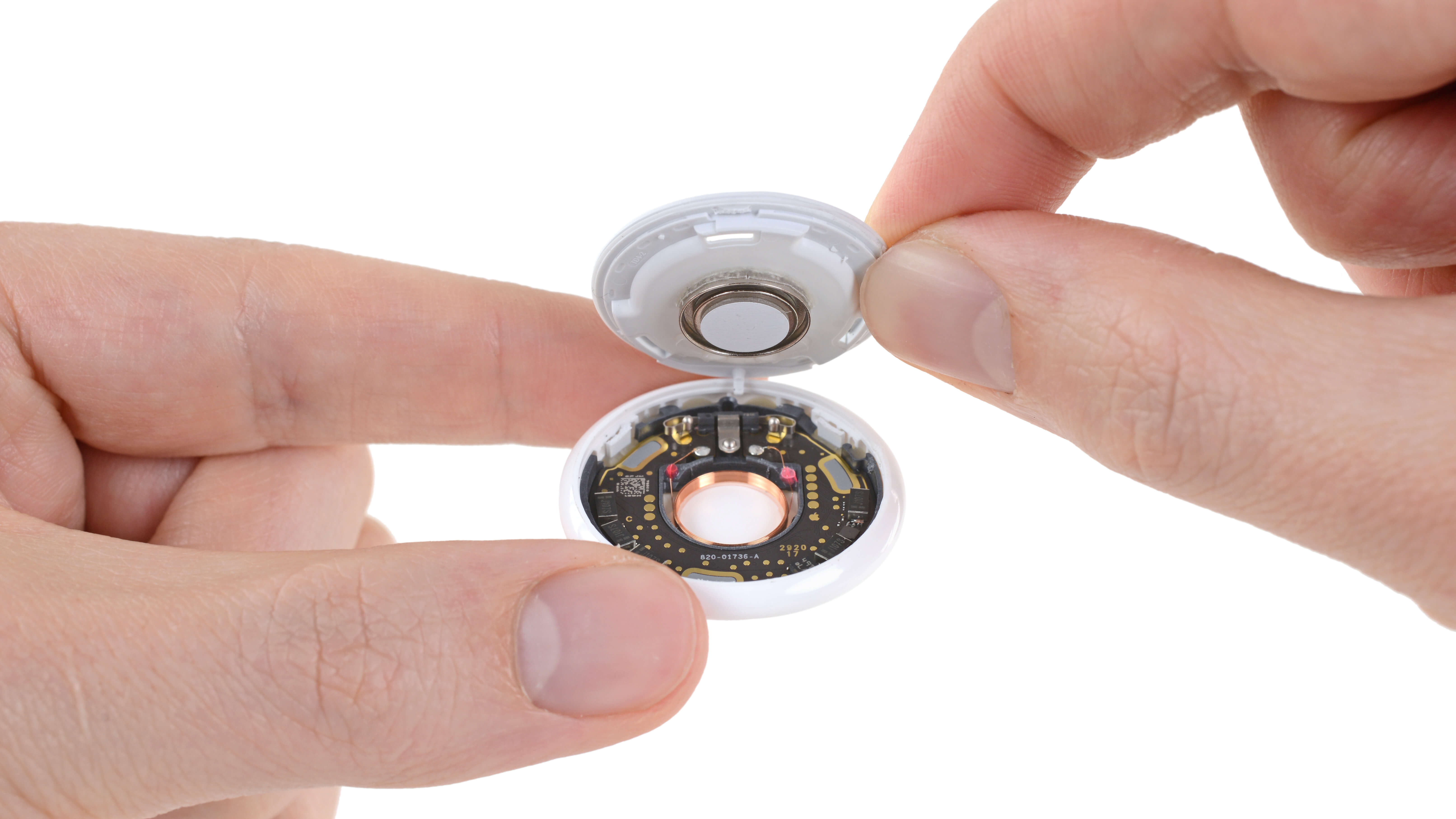Plus, there are attachment options for AirTags that are completely free!Truth, yes Apple sells accessories, well-engineered, good materials, but.....A lot of manufacturers also sell accessories, some as good, some better, some more expensive, most way cheaper.
Got a tip for us?
Let us know
Become a MacRumors Supporter for $50/year with no ads, ability to filter front page stories, and private forums.
iFixit Shares AirTag Teardown Revealing 'Impressively Compact' Design Compared to Tile Mate and Galaxy SmartTag
- Thread starter MacRumors
- Start date
- Sort by reaction score
You are using an out of date browser. It may not display this or other websites correctly.
You should upgrade or use an alternative browser.
You should upgrade or use an alternative browser.
The amount of wasted space to incorporate a loop hole really highlights why the iPhone or most other Apple devices don't have user removable devices.iFixit has shared the first of their two-part series in tearing down Apple's AirTags items tracker, revealing that Apple had to make impressive design decisions to have achieved its small design, including rethinking the speaker layout.
For comparison, iFixit compared Apple's AirTags to the Tile Mate and the Samsung Galaxy SmartTag. Compared to the competition, AirTags is the smallest in size, with the most internal space used to house the battery itself. One notably design difference is AirTags lack of a built-in keyring hole, which iFixit attributes to Apple's history of "turning essential functions into premium, add-on accessories." An x-ray of the three devices does indeed show that Apple wasted no internal space for its item-tracker. On the other hand, the Tile Mate and Galaxy SmartTag seem to be "sprawling" with internal space, and despite their larger footprint, neither tracker includes ultra-wideband technology like AirTags. It is worth noting that Samsung recently launched an ultra-wideband variant of the Galaxy SmartTag; however, iFixit was unable to attain a piece for their comparison.
The Tile Mate, Galaxy SmartTag, and AirTags all feature coin cell replaceable batteries. AirTags and the Galaxy SmartTag use the .66Wh CR2032 battery, while the Tile Mate uses the smaller .39Wh CR1632 battery. AirTags features a twist and lift mechanism for its backplate in terms of battery replacement, but it doesn't include an easy way to lift the backplate if you happen to have greasy or slippery hands. Replacing the battery is the furthest an average customer will be able to get into their AirTag without proper tooling. Even in that case, iFixit says Apple showed "surprising restraint in sealing the AirTag," noting that completely opening the tracker only requires a vise and some plastic sticks.
AirTags features a built-in speaker which emits sounds when pinged by a paired iPhone through the Find My app, during set-up and other situations. However, given its small form factor, Apple had to think of a new way to fit a speaker into the tracker. With AirTags, Apple decided to use the entire body as the speaker driver, with the underside of the cover serving as the speaker's magnet. As we noted earlier this week, it is possible to drill a hole through AirTags to make up for its lack of a built-in keyring hole. Doing so will certainly void AirTags warranty, and while it is possible, it is a risk. As iFixit notes, "drilling in the wrong place can cause serious damage." iFixit says that the second part of their teardown will include detailed information on the AirTags circuit board and other hidden secrets. For everything you need to know about AirTags, be sure to check out our guide. Article Link: iFixit Shares AirTags Teardown Revealing 'Impressively Compact' Design Compared to Tile Mate and Galaxy SmartTag
Do you also believe in santa claus and the tooth fairy? Much like removing the 3.5mm plug in iDevices, it's all designed to sell additional products. Its akin to selling a car with no wheels.Well, I guess that partly explains the lack of a hole. It must have killed Apple designers to have all that unused space in order to accommodate the loop, so they redesigned it into a coin which minimised the wastage of space.
A molded corner to give it a teardrop shape would have taken nothing away from the device and given it greatly improved real work functionality.
But instead, we have people in awe of Apple purposely screwing over customers again, to push add-ons
Gosh. How many things do you lose?It may retail for $29, but it’s likely to sell in huge volumes. I am likely to get 8 to start with, I am sure others will get multiple.
After endlessly commenting re: Apple not designing for battery replacement... Have to give them kudos for the AirTag. Now if Apple would only dedicate itself to developing a "Fairphone option" for consumers who want to minimize impact of their consumption on the environment we can start to respect Tim Apple's enviro claims. Come on Apple Airtags shows you can do it.
It's fairly obvious iFixit is referencing Apple's accessories. I'm sure you already knew that. It would make no sense for iFixit to claim Apple turns essential functions into premium add-on accessories just so some random doodad can be sold on Amazon."Apple's history of "turning essential functions into premium, add-on accessories." Why do people keep saying such dumb things? Has anyone ever heard of amazon? here is a link: https://www.amazon.com/Protector-Co...ds=air+bag+accessories&qid=1619960776&sr=8-23". so 4 keyrings for $9.99, or 2.50/per. Does iFixit think that is expensive? If you do, you probably can't avoid a tracker by any manufacturer anyway.
Truth, yes Apple sells accessories, well-engineered, good materials, but.....A lot of manufacturers also sell accessories, some as good, some better, some more expensive, most way cheaper.
As an Amazon Associate, MacRumors earns a commission from qualifying purchases made through links in this post.
I am fine with Apple making these as thick as a Doughnut as long as the battery life can last a century (cough....cough)Is the one thing I’d be happy about Apple making thinner.
<< As iFixit notes, "drilling in the wrong place can cause serious damage." >>
So where exactly is the right place to drill? Because while it might be worth $29, IMHO, right now it’s not worth $29 PLUS another $29 for the loop.
So where exactly is the right place to drill? Because while it might be worth $29, IMHO, right now it’s not worth $29 PLUS another $29 for the loop.
Look closer - omg there's a tiny Apple Park in there!

That's indeed a very smart design... well done, Apple!
@Kylo83 You didn't really think this through, or? If someone steals your stuff and finds the AirTag they can as well discard the whole AirTag... So sealing doesn't help at all.
@Kylo83 You didn't really think this through, or? If someone steals your stuff and finds the AirTag they can as well discard the whole AirTag... So sealing doesn't help at all.
Yep, people will always do weird things for attention. There was another guy few years ago who implemented his own functional 3.5mm headphone jack in an iPhone that did lack it.I don’t know, mr posted an article earlier about a guy succesfully drilling a hole on the rim of an AirTag while keeping it functional, so there must be another reason, be it design, durability or just to sell accesories.
One notably design difference is AirTags lack of a built-in keyring hole, which iFixit attributes to Apple's history of "turning essential functions into premium, add-on accessories."
Pretty much sums up Apple’s approach to business. I never saw an advantage to using a 30-pin connector or lighting cable over a USB port to consumers but it must have earnt Apple some money.
I much prefer the current circular shape over a potential teardrop shape. And if you don't want to buy an expensive "case" for it, surely there are some cheap $2-$3 things on Amazon that work just as well. Based on your signature though, you won't be getting Airtags so the point is moot.Do you also believe in santa claus and the tooth fairy? Much like removing the 3.5mm plug in iDevices, it's all designed to sell additional products. Its akin to selling a car with no wheels.
A molded corner to give it a teardrop shape would have taken nothing away from the device and given it greatly improved real work functionality.
But instead, we have people in awe of Apple purposely screwing over customers again, to push add-ons
Both of those were created before USB had any sort of comparable function. Heck Apple even helped design usb-c connector with functions like reversibility that they pioneered in their lightning (not claiming there was no other reversible plug before lighting, but Apple definitely popularized it).Pretty much sums up Apple’s approach to business. I never saw an advantage to using a 30-pin connector or lighting cable over a USB port to consumers but it must have earnt Apple some money.
"Unfettered access"There’s like so MANY nefarious things you could do with these components and their unfettered anonymous access to any iPhone around.
Why don't you describe one of these many nefarious things to see how viable it is.
I just shoved it in one of my wallet compartments. No issues.I want a wallet version for sure.
That said, the AirTag is by far the most difficult, especially if you indulged in a snack earlier and have greasy digits.
Is this supposed to deter me on some level!? You will maybe open them every year! 😛
Is this supposed to deter me on some level!? You will maybe open them every year! 😛
What reversible plug came before. I don’t recall any.Both of those were created before USB had any sort of comparable function. Heck Apple even helped design usb-c connector with functions like reversibility that they pioneered in their lightning (not claiming there was no other reversible plug before lighting, but Apple definitely popularized it).
Of course there would be a Gen 2, the least they can do is update the Bluetooth and U1 chip. Maybe add new colors if they feel like it too.Wonder if we’ll ever see a Gen2 of this product. Is the one thing I’d be happy about Apple making thinner.
I noticed these have a firmware, i wonder if they will be able to push new features/updates to this first generation of the airtags. If not, I’m thinkinf the second gen airtags will be much better in terms of range and possibly reverse tracking.
Register on MacRumors! This sidebar will go away, and you'll see fewer ads.



